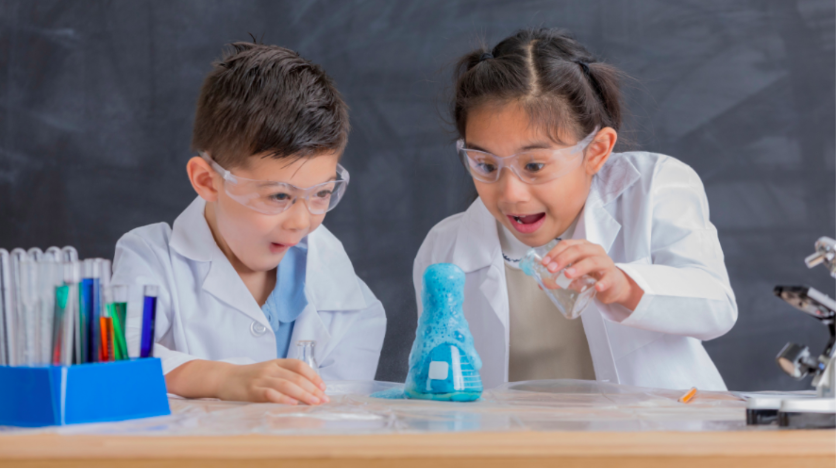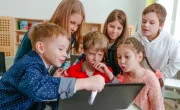5 Easy Science Experiments You Can Do With Everyday Items
Explore the Wonders of Science at Home – No Lab Required!
Have you ever watched your child ask, “Why does this happen?” or “How does this work?” That spark of curiosity is the beginning of a lifelong love for learning, and science is the perfect way to nurture it! The best part? You don’t need a fancy lab, expensive kits, or complicated tools. With just a few everyday items from your kitchen or bathroom cabinet, you can dive into the world of science experiments for kids right at home.
These simple science experiments for kids are more than just fun, they’re hands-on, educational, and perfect for encouraging problem-solving, critical thinking, and creativity. Whether you’re a parent, teacher, or just someone looking to share quality time with your little ones, these activities are suitable for kids (and curious adults!) of all ages.
So, grab your aprons, roll up your sleeves, and let’s explore the best science experiments for kids to do at home. These 5 experiments use items you already have, are safe, and guaranteed to delight.
Experiment 1: DIY Lava Lamp
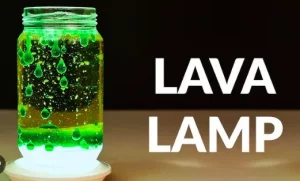
Concepts Demonstrated: Chemical Reactions
Materials Needed:
- A clear plastic or glass bottle
- Vinegar
- Vegetable oil
- Food coloring
- Baking Soda
Steps:
- Add a few heaps of baking soda to the bottle.
- Fill the rest of the bottle with vegetable oil (leave some space at the top).
- Use a dropper and add some coloured vinegar and watch the magic begin!
Scientific Explanation:
A classic reaction between vinegar and baking soda results in the formation of CO2 bubbles which are responsible for the fascinating lava lamp effect.
Safety Tip: Always supervise young children. Do not seal the bottle tightly while the reaction is occurring, as the gas buildup can cause pressure.
Experiment 2: Baking Soda and Vinegar Volcano
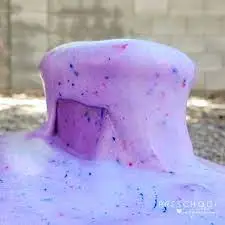
Concepts Demonstrated: Acid-Base Reactions, Chemical Change
Materials Needed:
- A cup or small bottle
- Baking soda
- Vinegar
- Dish soap (optional for extra froth)
- Red food coloring (to make it look like lava!)
- Tray or plate to catch the mess
Steps:
- Place your cup on the tray.
- Fill it halfway with baking soda.
- Add a few drops of food coloring and a squirt of dish soap.
- Pour vinegar into the cup and watch the eruption!
Scientific Explanation:
When vinegar (an acid) reacts with baking soda (a base), it produces carbon dioxide gas. The gas bubbles expand and create a foamy eruption that resembles lava bursting from a volcano!
Experiment 3: Balloon Magic
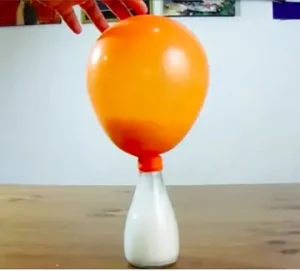
Concepts Demonstrated: Gas Production, Air Pressure
Materials Needed:
- Balloon
- Empty water bottle
- Baking soda
- Vinegar
- Funnel or spoon
Steps:
- Use a funnel to fill the balloon with 1–2 tablespoons of baking soda.
- Pour some vinegar into the bottle (about ¼ full).
- Carefully stretch the balloon over the bottle opening without letting the baking soda fall in yet.
- Lift the balloon to let the baking soda drop into the vinegar and watch it inflate!
Scientific Explanation:
The reaction between baking soda and vinegar creates carbon dioxide gas, which rises and fills the balloon. This shows how gas takes up space and can apply pressure!
Safety Tip: Be gentle when attaching the balloon to avoid spills.
Experiment 4: Dancing Raisins
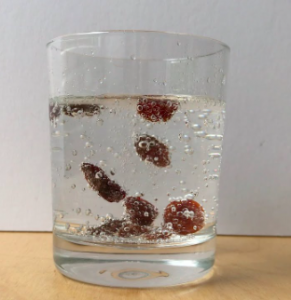
Concepts Demonstrated: Buoyancy, Gas Bubbles
Materials Needed:
- A clear glass
- Sparkling water or soda
- A handful of raisins
Steps:
- Pour sparkling water into the glass.
- Drop in a few raisins.
- Observe what happens after a few seconds!
- Alternatively, you can use vinegar and baking soda as a replacement if sparkling water isn’t available.
Scientific Explanation:
The bubbles from the soda stick to the raisins and lift them upward. When the bubbles pop at the surface, the raisins sink again. This simple movement looks like they’re dancing, thanks to the changes in buoyancy caused by gas bubbles.
Safety Tip: Avoid using sticky or sugary soda if possible; sparkling water is cleaner!
Experiment 5: Magic Milk Experiment
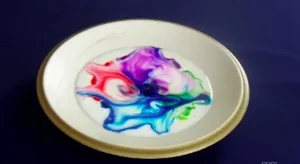
Concepts Demonstrated: Surface Tension
Materials Needed:
- Shallow dish
- Milk (whole milk works best)
- Food coloring
- Dish soap
- Cotton swabs
Steps:
- Pour milk into the dish to cover the bottom.
- Add drops of different food coloring around the surface.
- Dip a cotton swab in dish soap and touch it to the center of the milk.
- Watch the colors swirl and dance!
Scientific Explanation:
Milk contains fat, and dish soap breaks up that fat by reducing surface tension. As the molecules move, they push the food coloring around, creating a magical, swirling rainbow!
Why Try These Science Experiments for Kids?
These easy science experiments for kids are more than just weekend fun. They offer:
- Hands-on learning that makes scientific concepts real and memorable.
- Creative exploration – every child can make predictions, test hypotheses, and conclude.
- Screen-free bonding time for families or classrooms.
- A gateway to deeper interest in STEM (Science, Technology, Engineering, and Mathematics).
Whether you’re homeschooling, looking for a classroom activity, or simply want to enjoy rainy-day learning, these are the best science experiments for kids at home or school.
Conclusion: Science is All Around Us
You don’t need to be a scientist to explore the wonders of chemistry and physics. These simple science experiments for kids use the items in your kitchen to spark imagination, nurture curiosity, and inspire learning.
At Tickle Right, we believe that every child has the potential to think critically and explore the world with wonder. These experiments align perfectly with our mission to make learning fun, accessible, and developmentally enriching.
So go ahead, try these at home, share the excitement, and ignite a passion for science that lasts a lifetime.
Want more ideas or a guide to science activities? Follow us on Instagram or visit www.tickleright.com for more playful, brain-boosting fun!

